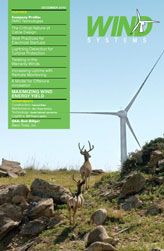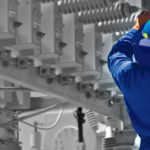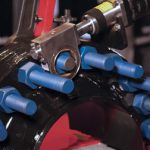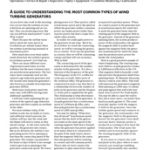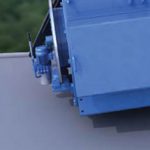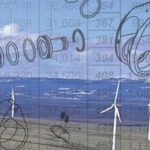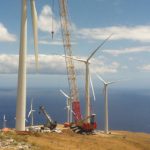Wind farm projects are a growing business segment for many electrical construction contractors. Although wind farms have been constructed for several years, owner/operators, engineering designers, and contractors continue to learn more effective and accurate methods for designing and implementing the farm’s electrical systems—systems that offer high integrity, reliability, and efficiency. Figure 1
Factors in Electrical Construction
All construction projects are driven by a comprehensive schedule that includes procurement, engineering, site preparation, foundation installation, erection, buildings, equipment installation, electrical cable pulls, termination, testing, and startup. But there are four primary factors that affect wind farm construction schedules. These include:
Engineering design issues discovered during construction: A close working relationship between project engineering designers and the construction contractor is necessary for effective problem resolution. Additionally, such relationships promote timely, accurate documentation and enables teams to work and get on and off site as quickly and safely as possible.
Site access limitations (Figure 2). Many wind farms are built on private sites, government reserves, or in locations isolated from large communities. Some are also built at high elevations. A well-established site entry plan, right of way permit, and an understanding of the time and costs needed to deliver equipment and materials to these sites is important to the farm’s rapid startup.
Covering large geographical areas. This requires construction and maintenance of many miles of roadways with conditions and accessibility that can quickly be adversely affected by traffic and weather. A well-designed road system with adequate design for load bearing and washout still requires constant maintenance and repair, and startup in the midst of very dry conditions requires frequent road watering to manage dust intrusion into systems. Both scenarios slow work progress and drive up costs (Figure 3).
The site is remote. As a result, local skilled labor is often used and supervised by the contractor. This can impede continuity and experience, however, hindering construction efficiency and production. It is a challenge to manage or predict, but is best minimized by maximizing the contractor’s employee participation.
Strategies for Startup Success
During wind farm construction, the one schedule segment that is relatively short in duration but perhaps the most important for the project’s success is the electrical systems testing and startup. This begins with each wind turbine going through extensive Factory Acceptance Testing (FAT) by the manufacturer. After transport from the factory to the project location and field assembly, however, the turbine must also go through a thorough Site Acceptance Testing (SAT). The turbine SAT is often performed by the manufacturer’s representative or by a testing group under their guidance (Figure 4).
The remaining electrical apparatus, components, cabling, switchgear, metering, protection, communications, and controls for the farm are thoroughly tested and reviewed by specialized, well-trained, and highly skilled technicians. Every aspect of the electrical system, from the turbine to the substation connecting the wind farm to the grid, must be tested for proper design and operation by skilled power technicians.
More qualified service companies have power technicians with experience in electrical power testing included in every aspect of a wind farm, from the turbine to the grid. A thorough understanding of wind farm electrical design, experience with power system components, and the ability to interface with contractors, designers, and utility systems are all important to successfully starting up and connecting a wind farm to the grid.
Nevertheless, every new project brings new challenges to the startup team. For example, new electrical equipment is found in a new turbine that has come onto the market; a farm’s electrical system needs to be upgraded to meet OSHA and FPHA codes, or a power distribution and control schematic that has never been seen by the team is deployed to a new farm. Each of these can be quite challenging for even the most experienced technician.
Since protection, controls, metering, monitoring, and communication systems technology is constantly evolving, a technician’s skills must also evolve to meet the new testing requirements for these devices. Many of the newer testing tools are computer based devices, so a qualified power technician must also have proficient computer skills to effectively use these tools. Technicians must also have a mathematical aptitude since substantial mathematics and a solid understanding of three-phase power systems is needed.
Unifying Multiple Electrical Components
There are many types of electrical equipment and components from the grid back to the turbines. All of this equipment must be thoroughly tested for insulation integrity and functionality, and the use of set points must often be applied to properly insulate, control, meter, and protect each unique system. These include:
• Power cables
• Distribution transformers
• Inverters/Converters
• Capacitors/Reactors
• Switchgear
• Extra high, high, medium, and low voltage breakers
• Metering
• Relaying
• SCADA
• Communications systems
• Power transformers
• Instrument transformers
• Battery systems
In the electrical construction and startup of a wind farm, the devices and conductors are installed and tested first. After the conductors are terminated, AC and DC control systems are temporarily energized so that the protection, control, metering, and instrument transformer systems can be verified and tested for proper design and operation. Power technicians often work with construction engineering to tweak the equipment design as issues are discovered during testing. If mistakes are made by a wireman during conductor termination, the power technician will discover them during checkout and work with the wireman to make corrections. This step must be thorough to help minimize safety risks and ensure system integrity (Figure 5).
Next, all systems are protected by complex relaying devices. These relays often require the installation of programmable logic files, each of which is a set logic based on rules written as a computer-controlling program. Through the use of computer-based testing devices and sophisticated testing software, an experienced power technician will verify the protection and metering systems and then assist construction engineering with any needed changes. This step must be carefully executed, as minor mistakes in setting the files can often appear as a wiring error or an equipment flaw later and could result in taking the commissioning process down the wrong path for hours, and sometimes days. Installing the correct files and validating that they were set up correctly is critical, as it can preserve valuable startup time.
Energizing the System
After all devices and systems are tested and all problems found and corrected, technical teams work with the operations group to start up and energize the entire system. The startup energization procedure must be a sound plan that requires personnel safety and system protection. Energization most often starts at the point of connection to the grid, and then it is stepped back along the way toward open connections along the collection grid up to each turbine. The turbines are then started up and synchronized with the utility system. There are no shortcuts in this process. One has to establish zones of correctly working equipment and cabling backward from the point of grid connection to cost-effectively energize a site, otherwise commissioning untested zones with tested zones will result in lost time and money as teams backtrack to make corrections.
Each energization step requires the power technician to perform a number of verification tests such as system voltage phasing, voltage rotation, voltage and current vector relationships measured at the protective relaying, and metering equipment. Some service companies believe one test is good enough, but if there is a problem there usually is not enough information to quickly identify and address it. In comparison, it may take more time to conduct multiple tests and document the results in at the outset, but it will to help shorten problem-resolution times in the future.
Finally, a project is not complete until all drawings have been redlined and modified to reflect all field changes, all testing documentation is completed and organized, and the customer has been presented with the upgrade to the farm’s electrical system. Upgrades represent any change to a farm’s design, regardless of how minor. This is extremely important, as many service companies do not invest the time to instruct owners about the new condition of the farm, which is necessary for further farm upgrades—again, avoiding future operations and maintenance issues.
Attention to Detail
American Electric Technologies, Inc. (AETI), has been providing electrical services for more than 30 years and has service technicians with an average of more than 20 years of experience each. Leveraging its experience in industrial and marine traditional energy for wind farm electrical services, AETI has developed a unique framework for successfully addressing the issues of today’s wind farm electrical system testing, commissioning, and startup energization.
Known as AIRDAP, this framework stands for “Attention to all details, Identification of any issue, Rapid resolution of issues as they appear, Documentation of any changes to the electrical system, Avoidance of leaving any problem behind, and Presentation of all information to the operator. As discussed, the successful startup of the wind farm’s electrical systems requires significant attention to every detail to ensure safety while driving down time and cost.
As the startup progresses from the grid toward the turbines, every issue identified must be resolved before proceeding to further contain costs. And to avoid leaving issues on the farm that will hinder future progress, documentation and presentation of all findings to the operator is critical, ensuring wind farm integrity, reliability, and containment of operations costs in the long term.



















